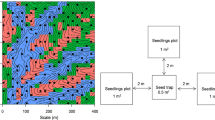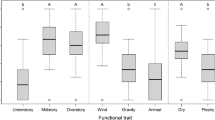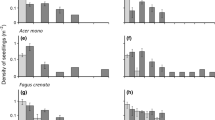Abstract
Recent evidence suggests that plant performance can be influenced by the phylogenetic diversity of neighboring plants. However, no study to date has examined the effect of such phylogenetic density dependence on the transition from seed to seedling. Using 6 years of data on seedling recruitment and seed rain of 13 species from 130 stations (one 0.5 m2 seed trap and three adjacent 1 m2 seedling plots) in a subtropical evergreen forest, we asked: (1) Does negative density dependence act across seed to seedling stages? (2) Is there evidence for phylogenetic density dependence during the seed to seedling transition? (3) Does the strength of density dependence vary among years? Generalized linear mixed-effects models were used to model seed to seedling transition as a function of conspecific seed and seedling densities, heterospecific seed and seedling densities, and mean phylogenetic distance of heterospecific seeds and seedling. Conspecific seed density had a significant negative effect on seedling transition rates for 12 of 13 focal species. In contrast, conspecific seedling density had a positive effect for 7 species, suggesting species-specific habitat preferences. Few species were significantly affected by the density or phylogenetic relatedness of heterospecific seeds and seedlings. Only conspecific seed density effects varied among years for most focal species. Overall, our results reveal that conspecific seed and seedling densities play a more important role than the density or relatedness of heterospecific seeds and seedlings during the seed to seedling stage, suggesting that species-specific seed predators, along with habitat preferences, may contribute to diversity maintenance in this forest.

Similar content being viewed by others
References
Altschul SF, Madden TL, Schaffer AA, Zhang J, Zhang Z, Miller W, Lipman DJ (1997) Gapped BLAST and PSI-BLAST: a new generation of protein database search programs. Nucl Acids Res 25:3389–3402. doi:10.1093/nar/25.17.3389
Bachelot B, Kobe RK, Vriesendorp C (2015) Negative density-dependent mortality varies over time in a wet tropical forest, advantaging rare species, common species, or no species. Oecologia 179:853–861. doi:10.1007/s00442-015-3402-7
Bagchi R, Swinfield T, Gallery RE, Lewis OT, Gripenberg S, Narayan L, Freckleton RP (2010) Testing the Janzen-Connell mechanism: pathogens cause overcompensating density dependence in a tropical tree. Ecol Lett 13:1262–1269. doi:10.1111/j.1461-0248.2010.01520.x
Bagchi R, Gallery RE, Gripenberg S, Gurr SJ, Narayan L, Addis CE, Freckleton RP, Lewis OT (2014) Pathogens and insect herbivores drive rain forest plant diversity and composition. Nature 506:85–88. doi:10.1038/nature12911
Bates D, Maechler M, Bolker B (2012) lme4: Linear mixed-effects models using s4 classes. R Package Version 3.0.3. http://CRAN.R-project.org/package=lme4. Accessed 22 June 2012
Bell T, Freckleton RP, Lewis OT (2006) Plant pathogens drive density-dependent seedling mortality in a tropical tree. Ecol Lett 9:569–574. doi:10.1111/j.1461-0248.2006.00905.x
Chen L, Mi XC, Comita LS, Zhang LW, Ren HB, Ma KP (2010) Community-level consequences of density dependence and habitat association in a subtropical broad-leaved forest. Ecol Lett 13:695–704. doi:10.1111/j.1461-0248.2010.01468.x
Chesson P (2000) Mechanisms of maintenance of species diversity. Annu Rev Ecol Evol Syst 31:343–366. doi:10.1146/annurev.ecolsys.31.1.343
Comita LS, Hubbell SP (2009) Local neighborhood and species’ shade tolerance influence survival in a diverse seedling bank. Ecology 90:328–334. doi:10.1890/08-0451.1
Comita LS, Uriarte M, Thompson J, Jonckheere I, Canham CD, Zimmerman JK (2009) Abiotic and biotic drivers of seedling survival in a hurricane-impacted forest. J Ecol 97:1346–1359. doi:10.1111/j.1365-2745.2009.01551.x
Comita LS, Muller-Landau HC, Aguilar S, Hubbell SP (2010) Asymmetric density dependence shapes species abundances in a tropical tree community. Science 329:330–332. doi:10.1126/science.1190772
Comita LS, Queenborough SA, Murphy S, Eck JL, Xu KY, Krishnadas M, Beckman N, Zhu Y (2014) Testing predictions of the Janzen-Connell hypothesis: a meta-analysis of experimental evidence for distance and density-dependent seed and seedling survival. J Ecol 102:845–856. doi:10.1111/1365-2745.12232
Connell JH (1971) On the role of natural enemies in preventing competitive exclusion in some marine animals and rain forest trees. In: der Boer PJ, Gradell GR (eds) Dynamics of numbers in populations. Center for Agricultural Publishing and Documentation, Wageningen, pp 298–312
Denslow JS (1987) Tropical rain forest gaps and tree species diversity. Annu Rev Ecol Evol Syst 18:431–451. doi:10.1146/annurev.es.18.110187.002243
Du YJ, Ma KP (2012) Temporal and spatial variation of seedfall in a broad-leaved evergreen forest in Gutianshan nature reserve of Zhejiang Province, China. Chin J Plant Ecol 36:717–728. doi:10.3724/SP.J.1258.2012.00717
Edgar RC (2004) MUSCLE: multiple sequence alignment with high accuracy and high throughput. Nucl Acids Res 32:1792–1797. doi:10.1093/nar/gkh340
Feng G, Svenning J, Mi XC, Jia Q, Rao MD, Ren HB, Bebber DP, Ma KP (2014) Anthropogenic disturbance shapes phylogenetic and functional tree community structure in a subtropical forest. For Ecol Manag 313:188–198. doi:10.1016/j.foreco.2013.10.047
Fenner M (1985) Seed Ecology. Chapman and Hall, New York. doi:10.1007/978-94-009-4884-0
Fritschie KJ, Cardinale BJ, Alexandrou MA, Oakley TH (2013) Evolutionary history and the strength of species interactions: testing the phylogenetic limiting similarity hypothesis. Ecology 95:1407–1417. doi:10.1890/13-0986.1
Garzon-Lopez CX, Ballesteros-Mejia L, Ordoñez A, Bohlman SA, Olff H, Jansen PA (2015) Indirect interactions among tropical tree species through shared rodent seed predators: a novel mechanism of tree species coexistence. Ecol Lett 18:752–760. doi:10.1111/ele.12452
Gilbert GS, Webb CO (2007) Phylogenetic signal in plant pathogen-host range. Proc Natl Acad Sci USA 104:4979–4983. doi:10.1073/pnas.0607968104
Hanski I, Hansson Henttonen L (1991) Specialist predators, generalist predators, and the microtine rodent cycle. J Ecol 60:353–367. doi:10.2307/5465
Harms KE, Wright SJ, Calderon O, Hernandez A, Herre EA (2000) Pervasive density-dependent recruitment enhances seedling diversity in a tropical forest. Nature 404:493–495. doi:10.1038/35006630
Hille Ris Lambers J, Clark JS, Beckage B (2002) Density-dependent mortality and the latitudinal gradient in species diversity. Nature 417:732–735. doi:10.1038/nature00809
Hu ZH, Yu MJ, Ding BY, Fang T, Qian HY, Chen QC (2003) Types of evergreen broadleaved forests and the species diversity in Gutianshan Mountain nature reserve. Chin J Appl Environ Biol 9:341–345
Ibanez I, Clark JS, LaDeau S, Hille Ris Lambers J (2007) Exploiting temporal variability to understand tree recruitment response to climate change. Ecol Monogr 77:163–177. doi:10.1890/06-1097
Inman-Narahari F, Ostertag F, Hubbell SP, Giardina CP, Cordell S, Sack L (2016) Density-dependent seedling mortality varies with light availability and species abundance in wet and dry Hawaiian forests. J Ecol 104:773–780. doi:10.1111/1365-2745.12553
Janzen DH (1970) Herbivores and the number of tree species in tropical forests. Am Nat 104:501–528. doi:10.1086/282687
Janzen DH (1980) Specificity of seed-attacking beetles in a Costa Rican deciduous forest. J Ecol 68:929–952. doi:10.2307/2259466
Johnson D, Beaulieu WT, Bever JD, Clay K (2012) Conspecific negative density dependence and forest diversity. Science 336:904–907. doi:10.1126/science.1220269
Jones FA, Comita LS (2010) Density-dependent pre-dispersal seed predation and fruit set in a tropical tree. Oikos 119:1841–1847. doi:10.1111/j.1600-0706.2010.18547.x
Khanuja SPS, Shasany AK, Darokar MP, Kumar S (1999) Rapid isolation of DNA from dry and freshsamples of plants producing large amounts of secondary metabolites and essential oils. Plant Mol Biol Rep 17:74. doi:10.1023/A:1007528101452
Kress WJ, Erickson DL, Jones FA, Swenson NG, Perez R, Sanjur O, Bermingham E (2009) Plant DNA barcodes and a community phylogeny of a tropical forest dynamics plot in Panama. Proc Natl Acad Sci USA 106:18621–18626. doi:10.1073/pnas.0909820106
LaManna JA, Walton ML, Turner BL, Myers JA (2016) Negative density dependence is stronger in resource-rich environments and diversifies communities when stronger for common but not rare species. Ecol Lett 19:657–667. doi:10.1111/ele.12603
Lebrija-Trejos E, Wright SJ, Hernandez A, Reich PB (2014) Does relatedness matter? Phylogenetic density-dependent survival of seedlings in a tropical forest. Ecology 95:940–951. doi:10.1890/13-0623.1
Lebrija-Trejos E, Reich PB, Hernandez A, Wright SJ (2016) Species with greater seed mass are more tolerant of conspecific neighbours: a key driver of early survival and future abundances in a tropical forest. Ecol Lett 19:1071–1080. doi:10.1111/ele.12643
Letten AD, Cornwell WK (2015) Trees, branches and (square) roots: why evolutionary relatedness is not linearly related to functional distance. Methods Ecol Evol 6:439–444. doi:10.1111/2041-210X.12237
Liang M, Liu X, Etienne RS, Huang F, Wang Y, Yu S (2015) Arbuscular mycorrhizal fungi counteract the Janzen-Connell effect of soil pathogens. Ecology 96:562–574. doi:10.1890/14-0871.1
Lin LX, Comita LS, Zheng Z, Cao M (2012) Seasonal differentiation in density-dependent seedling survival in a tropical rainforest. J Ecol 100:905–914. doi:10.1111/j.1365-2745.2012.01964.x
Liu XB, Liang MX, Etienne RS, Wang YF, Staehelin C, Yu SX (2012) Experimental evidence for a phylogenetic Janzen-Connell effect in a subtropical forest. Ecol Lett 15:111–118. doi:10.1111/j.1461-0248.2011.01715.x
Masaki T, Osumi K, Takahashi K, Hoshizaki K, Matsune K, Suzuki W (2007) Effects of microenvironmental heterogeneity on the seed-to-seedling process and tree coexistence in a riparian forest. Ecol Res 22:724–734. doi:10.1007/s11284-006-0308-1
Metz MR, Sousa WP, Valencia R (2010) Widespread density-dependent seedling mortality promotes species coexistence in a highly diverse Amazonian rain forest. Ecology 91:3675–3685. doi:10.1890/08-2323.1
Mi XC, Swenson NG, Jia Q, Rao MD, Feng G, Ren HB, Bebber DP, Ma KP (2016) Stochastic assembly in a subtropical forest chronosequence: evidence from contrasting changes of species, phylogenetic and functional dissimilarity over succession. Sci Rep 6:32596. doi:10.1038/srep32596
Morris WF, Hufbauer RA, Agrawal AA, Bever JD, Borowicz VA, Gilbert GS, Maron J, Mitchell CE, Parker IM, Power AG, Torchin ME, Vazquez DP (2007) Direct and interactive effects of enemies and mutualists on plant performance: a meta-analysis. Ecology 88:1021–1029. doi:10.1890/06-0442
Muscarella R, Uriarte M, Forero-Montaña J, Comita LS, Swenson NG, Thompson J, Nytch CJ, Jonckheere I, Zimmerman JK (2013) Life-history trade-offs during the seed-to-seedling transition in a subtropical wet forest community. J Ecol 101:171–182. doi:10.1111/1365-2745.12027
Narwani A, Alexandrou MA, Oakley TH, Carroll IT, Cardinale BJ (2013) Experimental evidence that evolutionary relatedness does not affect the ecological mechanisms of coexistence in freshwater green algae. Ecol Lett 16:1373–1381. doi:10.1111/1365-2745.12027
Naughton HR, Alexandrou MA, Oakley TH, Cardinale BJ (2015) Phylogenetic distance does not predict competition in green algal communities. Ecosphere 6:1–19. doi:10.1890/ES14-00502.1
Novotny V, Basset Y, Miller SE, Weiblen GD, Bremer B, Cizek L, Drozd P (2002) Low host specificity of herbivorous insects in a tropical forest. Nature 416:841–844. doi:10.1038/416841a
Paine CET, Harms KE, Schnitzer SA, Carson WP (2008) Weak competition among tropical tree seedlings: implications for species coexistence. Biotropica 40:432–440. doi:10.1111/j.1744-7429.2007.00390.x
Paine CET, Norden N, Chave J, Forget PM, Fortunel C, Dexter KG, Baraloto C (2012) Phylogenetic density dependence and environmental filtering predict seedling mortality in a tropical forest. Ecol Lett 15:34–41. doi:10.1111/j.1461-0248.2011.01705.x
Queenborough SA, Burslem DFRP, Garwood NC, Valencia R (2007) Neighborhood and community interactions determine the spatial pattern of tropical tree seedling survival. Ecology 88:2248–2258. doi:10.1890/06-0737.1
R Development Core Team (2014) R: a Language and environment for statistical computing. R Foundation for Statistical Computing. Available at http://www.R-project.org. Accessed 6 Mar 2014
Sanderson MJ (2003) r8 s: inferring absolute rates of molecular evolution and divergence times in the absence of a molecular clock. Bioinformatics 19:301–302. doi:10.1093/bioinformatics/19.2.301
Shi LL, Luo ZR, Xia JT, Zhao WJ, Wu YG, Ding BY (2014) Woody seedling dynamics and the correlation between habitat and regeneration mortality in a subtropical evergreen broad-leaved forest in China. Acta Ecol Sin 34:6510–6518. doi:10.5846/stxb201302150268
Stamatakis A (2006) RAxML-VI-HPC: maximum likelihood-based phylogenetic analyses with thousands of taxa and mixed models. Bioinformatics 22:2688–2690. doi:10.1093/bioinformatics/btl446
Swamy V, Terborgh J, Dexter KG, Best BD, Alvarez P, Cornejo F (2011) Are all seeds equal? Spatially explicit comparisons of seed fall and sapling recruitment in a tropical forest. Ecol Lett 14:195–201. doi:10.1111/j.1461-0248.2010.01571.x
Umaña MN, Forero-Montaña J, Muscarella R, Nytch CJ, Uriarte M, Zimmerman JK, Swenson NG (2016) Inter-specific functional convergence and divergence and intra-specific negative density dependence underlie the seed-to-seedling transition in tropical trees. Am Nat 187:99–109. doi:10.1086/684174
Uriarte M, Condit R, Canham CD, Hubbell SP (2004) A spatially explicit model of sapling growth in a tropical forest: does the identity of neighbours matter? J Ecol 92:348–360. doi:10.1111/j.0022-0477.2004.00867.x
Venail PA, Narwani A, Fritschie K, Alexandrou MA, Oakley TH, Cardinale BJ (2014) The influence of phylogenetic relatedness on species interactions among freshwater green algae in a mesocosm experiment. J Ecol 102:1288–1299. doi:10.1111/1365-2745.12271
Webb CO, Gilbert GS, Donoghue MJ (2006) Phylodiversity-dependent seedling mortality, size structure, and disease in a Bornean rain forest. Ecology 87:123–131. doi:10.1890/0012-9658(2006)87
Wills C (1996) Safety in diversity. N Sci 149:38–42
Wright SJ (2002) Plant diversity in tropical forests: a review of mechanisms of species coexistence. Oecologia 130:1–14. doi:10.1007/s004420100809
Wright SJ, Muller-Landau HC, Calderon O, Hernandez A (2005) Annual and spatial variation in seed fall and seedling recruitment in a neotropical forest. Ecology 86:848–860. doi:10.1007/s004420100809
Wright SJ, Calderon O, Hernandez A, Detto M, Jansen PA (2016) Interspecific associations in seed arrival and seedling recruitment in a neotropical forest. Ecology 97:2780–2790. doi:10.1002/ecy.1519
Wu JJ, Swenson NG, Brown C, Zhang CC, Yang J, Ci XQ, Li J, Sha LQ, Cao M, Lin LX (2016) How does habitat filtering affect the detection of conspecific and phylogenetic density dependence? Ecology 97:1182–1193. doi:10.1890/14-2465.1
Zhang JL, Mi XC, Pei NC (2010) Phylotools: phylogenetic tools for ecologists. R package version 0.0.7.4. 201019
Zhu Y, Mi XC, Ren HB, Ma KP (2010) Density dependence is prevalent in a heterogeneous subtropical forest. Oikos 119:109–119. doi:10.1111/j.1600-0706.2009.17758
Zhu Y, Getzin S, Wiegand S, Ren HB, Ma KP (2013) The relative importance of Janzen-Connell effects in influencing the spatial patterns at the Gutianshan subtropical forest. PLoS One 8(9):e74560. doi:10.1371/journal.pone.0074560
Zhu Y, Comita LS, Hubbell SP, Ma KP (2015) Conspecific and phylogenetic density-dependent survival differs across life stages in a tropical forest. J Ecol 103:957–966. doi:10.1111/1365-2745.12414
Acknowledgements
We thank Dr. Lebrija-Trejos for sharing R code for calculating phylodiversity and Jinlong Zhang for building the phylogenetic tree. Yanjun Du was financially supported by Research Division of Biodiversity and Conservation Ecology (80006F2005) and National Natural Science Foundation of China (Y32H3A1001). Yanjun Du is appreciative of the visiting scholar program at Yale University and the China Scholarship Council, which supported his visit.
Author contribution statement
YJD, KPM and LSC developed the original idea; LC, XCM and YJD conducted the fieldwork. YJD, YQW, and LSC analyzed the data. YJD, SAQ, LSC and KPM wrote the manuscript.
Author information
Authors and Affiliations
Corresponding author
Additional information
Communicated by Daniel Laughlin.
Electronic supplementary material
Below is the link to the electronic supplementary material.
Rights and permissions
About this article
Cite this article
Du, Y., Queenborough, S.A., Chen, L. et al. Intraspecific and phylogenetic density-dependent seedling recruitment in a subtropical evergreen forest. Oecologia 184, 193–203 (2017). https://doi.org/10.1007/s00442-017-3842-3
Received:
Accepted:
Published:
Issue Date:
DOI: https://doi.org/10.1007/s00442-017-3842-3




